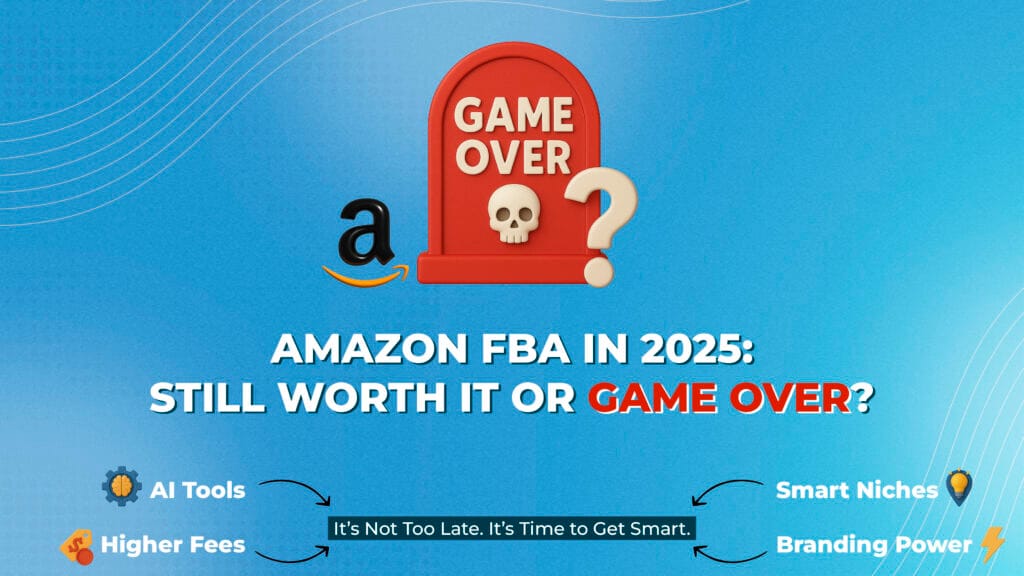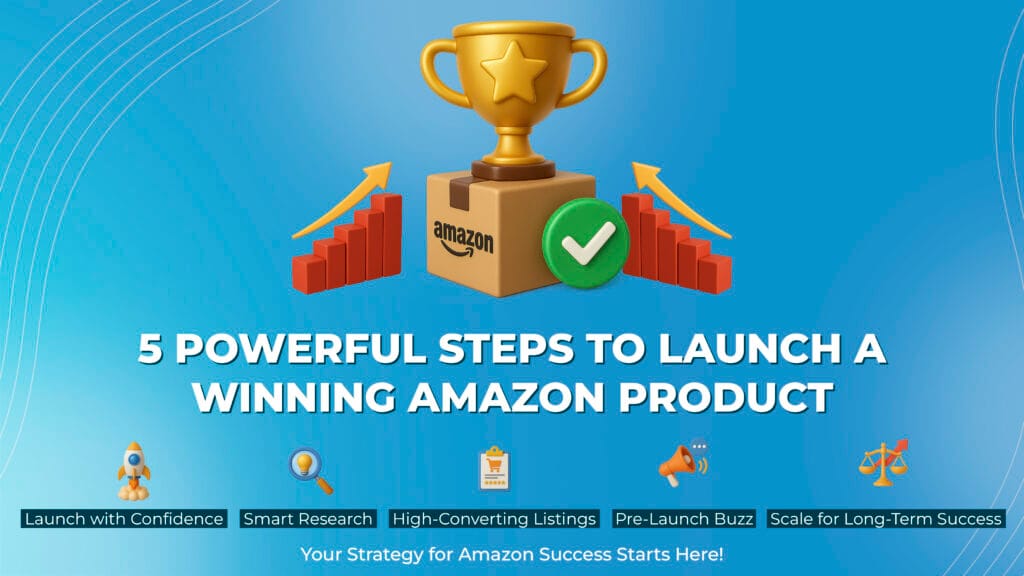Amazon FBA 2025: Should You Still Start or Is It Too Late?

In the golden days of Amazon FBA, launching a private label product could turn $1,000 into a thriving eCommerce business. Fast-forward to 2025, and many sellers, new and seasoned, are wondering: Is it still worth starting FBA, or has the ship sailed? This is the Truth about Amazon FBA 2025. Let’s examine where Amazon FBA stands in 2025, the hurdles new sellers face, and whether it’s still a viable opportunity or a money pit waiting to happen. What’s New in Amazon FBA 2025? Rising Fees FBA fulfillment and storage fees have increased significantly, by as much as 15–20% since 2023. This is partly due to Amazon’s investments in logistics and sustainability. While this puts pressure on profit margins, it also discourages low-effort sellers and opens doors for more serious entrepreneurs. AI & Automation Are the Norm Sellers now use AI tools for listing optimization, pricing, PPC campaigns, and even customer service. It’s not just an edge, it’s a necessity. Manual operations are falling behind, and sellers using tech platforms like ChatGPT, Helium 10, and SellerAmp are staying competitive. Stricter Compliance Amazon has tightened its policy enforcement. Many sellers report account suspensions for minor infractions. However, those who maintain compliance and appeal processes proactively are staying ahead. Why Many Say “It’s Too Late” 1. Market Saturation Thousands of new sellers enter the marketplace every month. Most product categories, especially in beauty, home, and fitness, are flooded with similar private label items, making it difficult to stand out. 2. Higher Barriers to Entry Once you factor in product development, shipping, inventory, branding, and ad spend, you’ll need $3,000 to $10,000+ to launch a competitive product in 2025. 3. Profit Margins Are Shrinking With inflation, fee hikes, and rising PPC costs, squeezing out profit is harder unless you build real brand equity. Why Amazon FBA is Still a Great Opportunity (If You Do It Right) 1. Niche Opportunities Are Thriving New sellers are succeeding in ultra-specific markets with products solving real pain points. A Reddit user shared how they targeted a low-search keyword niche and are now generating $15,000/month with minimal ad spend. Micro-niches work if you find the right angle. 2. Global Marketplaces Are Expanding Amazon UAE, Brazil, India, and Singapore are seeing fast growth. Sellers launching in underdeveloped marketplaces face less competition and better margins. 3. Branding is Everything Now What separates the winners in 2025 is one thing: branding. The days of white-labeled me-too products are over. If you’re willing to treat Amazon as a channel, not your whole business, and build a recognizable brand with great customer experience, you’re already in the top tier of new sellers. Gone are the days of reselling factory products with minimal changes. In 2025, winning sellers will build brands with quality packaging, compelling storytelling, and multichannel presence (Instagram, TikTok, DTC sites). Amazon FBA is now a channel, not the whole business. What It Takes to Succeed in 2025 Let’s be honest, launching an Amazon business in 2025 isn’t for the faint of heart. It’s not passive income. It’s not an overnight success. It’s a real business, and it demands real strategy, discipline, and patience. Product research is now a science. Tools like Helium 10, Jungle Scout, and Keepa aren’t optional; they’re foundational. Sellers use them not only to find opportunities, but also to avoid dangerous product categories, low-profit segments, or seasonal traps. Equally important is differentiation. You can’t rely on just a different color or bundled accessory. Your product has to solve a problem better than others or connect with a specific audience in a way your competitors don’t. Smart sellers now invest heavily in packaging, messaging, and customer support to stand out. And then there’s the technology. In 2025, successful sellers are leveraging AI for listing copywriting, automated chat replies, PPC bid optimization, and review monitoring. Manual management is not scalable anymore. Sellers need patience and capital more than anything. This isn’t a $500 side hustle anymore. The runway is longer, and break-even might not come until month six or later. But when it works, it scales. Hybrid Models Are Gaining Popularity In 2025, smart sellers are diversifying beyond private label. They combine FBA with: This hybrid model reduces risk and maximizes long-term brand control. Final Verdict: Is It Too Late? No, it’s not too late. But it is too late to wing it. If you’re looking for a quick, passive way to make money online, FBA probably isn’t your best bet anymore. But if you’re serious about building a long-term business, have some capital to invest, and are willing to treat it like a real venture, Amazon still offers an incredible opportunity. More importantly, the buyers are still there (millions of them) shopping every day, looking for better products and better brands. If you show up with something they actually want and market it effectively, the game is still very winnable. Ready to Launch a Winning Amazon Brand? If you’re thinking about starting Amazon FBA or launching your own private label brand but feel overwhelmed by all the changes in 2025, you’re not alone. That’s where Brand Aventus comes in. We specialize in helping serious entrepreneurs launch, scale, and dominate on Amazon with services like: Whether you’re just getting started or need help scaling your current store, we’ll help you build a profitable, future-proof Amazon business with data-driven strategies and hands-on support. Book your free FBA strategy call with Brand Aventus today and take the guesswork out of growing your eCommerce brand.
5 Powerful Steps to Launch a Winning Amazon Product

Launching an Amazon product successfully isn’t about luck; it’s about strategy. In the highly competitive Amazon marketplace, the right launch plan can generate early momentum, attract loyal customers, and position your brand for long-term growth. Here are five powerful, proven steps to ensure your Amazon product launch makes a lasting impact. 1. Validate Your Product with Smart Research Success on Amazon starts long before your product goes live. Solid research helps ensure you’re launching a product that people actually want and that you can compete in your chosen niche. Start by identifying trends and demand using tools like Jungle Scout, Helium 10, or AMZScout. These platforms can help you: Look closely at the top-performing listings in your category. Pay attention to what they do well and where they fall short. This will give you an opportunity to position your Amazon product as the better alternative. You can also hire an expert to conduct the product research for you. Contact us, and one of our experts will take this step off your plate. 2. Build a High-Converting Product Listing Your product listing is your digital storefront, and it’s often your only shot at turning browsers into buyers. It needs to be optimized for both Amazon’s algorithm (A9) and human psychology. Key components of a great listing include: According to Amazon Seller Central, a listing with 7+ images, optimized titles, and clear benefits tends to convert better. Use real customer language where possible, and test different elements over time to optimize performance. 3. Build Pre-Launch Buzz and Audience Interest One mistake new sellers often make is launching their Amazon product in silence, simply going live and hoping the platform does the work. But without initial traffic or social proof, your listing can be overlooked. That’s why building anticipation before launch is so important. Start by working with influencers or bloggers in your niche. You don’t need massive accounts; in fact, micro-influencers often have higher engagement and are more affordable. Provide them with samples ahead of time so they can review or promote your product when you go live. Contact us today, and we can connect you with appropriate influencers who can help you build the hype. Another powerful pre-launch tactic is setting up a simple landing page where people can sign up for early access or an exclusive launch discount. Services like ConvertKit or Mailchimp make it easy to collect emails and send automated sequences to drive traffic on launch day. By the time your product is live, you want a warm audience ready to buy. That early momentum can help your product rank better in Amazon’s search algorithm, known as the A9. 4. Choose the Right Launch Strategy to Drive Momentum Once your Amazon product is listed, you’ll need a smart launch plan that aligns with your goals, audience, and inventory readiness. There are three common launch strategies, each suited to different seller needs. Soft Launch A soft launch is ideal for new sellers or those testing a new product category. It involves minimal promotion and focuses on gathering feedback, optimizing your listing, and validating demand. Benefits of a soft launch: This strategy works best when you’re still learning the ropes or when launching a new Amazon product without a large existing audience. Hard Launch A hard launch involves an aggressive promotional push from day one. You’ll use Amazon PPC, influencer campaigns, social media ads, and email marketing to drive immediate traffic and sales. It’s best for: A hard launch requires coordination and budget. You’ll need inventory ready, customer support on standby, and ad campaigns dialed in to handle the influx. Seasonal Launch This type of launch targets peak shopping periods like Q4, Black Friday, or Prime Day. It’s ideal for products that align with seasonal demand or make great gifts. Key considerations for seasonal launches: The upside? Massive volume potential. The downside? High competition and the risk of stockouts if demand exceeds forecasts. Whichever strategy you choose, make sure you launch with at least 5–10 initial reviews (via Amazon Vine or ethical email follow-ups), use targeted Amazon ads to drive traffic, and offer limited-time deals or coupons to boost conversions. Launching without momentum is like opening a store in the desert. These strategies give you the visibility and sales velocity needed to thrive. 5. Optimize and Scale for Long-Term Growth Your work is far from over after launch. The post-launch phase is where true growth happens. This is when you gather data, test changes, and optimize to improve performance and scale profitably. Focus on: Customer feedback is another goldmine. If reviews highlight a recurring flaw or complaint, act fast. A minor product tweak can result in better ratings and more sales. Once your Amazon product is gaining traction, explore options to scale: Scaling smartly ensures your success isn’t short-lived. With each launch, you become more efficient, more data-driven, and better positioned to build a lasting brand. Conclusion Launching an Amazon product is no longer a simple plug-and-play task. It’s a process that requires preparation, strategy, and continual improvement. Whether you choose a soft launch to test the waters, a hard launch to make a big splash, or a seasonal approach to ride the wave of demand, what matters most is that your plan fits your product and goals. The most successful sellers treat their Amazon business like a brand, not just a one-time sale. If you follow these five steps with the right mindset and tools, you’ll set yourself up for sustainable growth and long-term success on the platform. Ready to Launch Your Amazon Product the Right Way? At Brand Aventus, we specialize in turning product ideas into profitable Amazon success stories. Whether you’re launching for the first time or looking to scale, our team of experts handles everything: from listing optimization and PPC management to influencer outreach and launch strategy. Don’t go it alone, partner with Brand Aventus and launch with confidence. Get in touch with us today and let’s make your Amazon product a bestseller.


